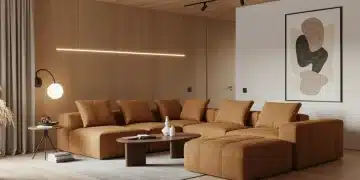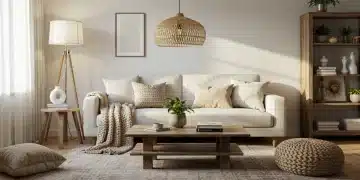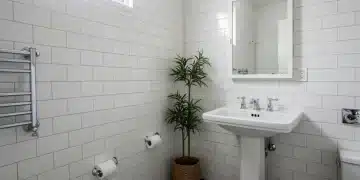Create a Stylish Home Office: Maximize Productivity in Small Spaces

Creating a stylish and productive home office in a small space requires strategic planning, smart furniture choices, and efficient organization to maximize functionality and aesthetic appeal.
In today’s evolving work landscape, the concept of a home office has shifted from a luxury to a necessity for many. However, not everyone has the luxury of a dedicated room. This article will guide you on how to create a stylish home office: maximize productivity in a small space, transforming even the tiniest nook into a functional and inspiring workspace. We’ll explore innovative design ideas, smart storage solutions, and ergonomic considerations to ensure your compact office supports both your workflow and well-being.
Defining Your Workspace: Location and Layout
The first step in crafting an effective small home office is to carefully select its location and plan its layout. Even if you don’t have an entire room, identifying a specific zone for work helps establish boundaries and mental separation between professional and personal life. Consider areas that might be underutilized but offer enough quiet and light.
Think about corners in living rooms, hallways, or even a spacious closet that can be repurposed. The key is to find a spot where you can minimize distractions and maximize focus. Natural light is a significant advantage, as it can boost mood and reduce eye strain, so positioning your desk near a window is often ideal.
Strategic Placement for Optimal Flow
Once you’ve identified a potential spot, visualize how your furniture will fit and how you’ll move within the space. Measure carefully to avoid overcrowding. A well-planned layout ensures that your office feels integrated into your home rather than an afterthought, enhancing both aesthetics and functionality.
- Corner Nooks: Utilize awkward corners with L-shaped desks or custom-built solutions.
- Closet Conversions: Transform a spare closet into a ‘cloffice’ by removing doors and adding shelving.
- Under-Stair Areas: Maximize often-ignored spaces for a compact, tucked-away workstation.
A thoughtfully chosen location and an efficient layout are foundational to creating a stylish small home office. This initial planning prevents future frustrations and ensures that every inch of your designated workspace serves a purpose, contributing to an environment where productivity can thrive.
Smart Furniture Choices: Multi-functional and Space-Saving
When working with limited square footage, every piece of furniture must earn its place. Opting for multi-functional and space-saving furniture is paramount to successfully create a stylish home office: maximize productivity in a small space. These pieces not only save room but also contribute to a clutter-free and visually appealing environment.
Consider items that serve dual purposes, such as a desk that folds away when not in use, or shelves that double as room dividers. The goal is to maintain flexibility in your living area while providing a dedicated workspace when needed. Investing in quality, adaptable furniture will pay dividends in both comfort and efficiency.
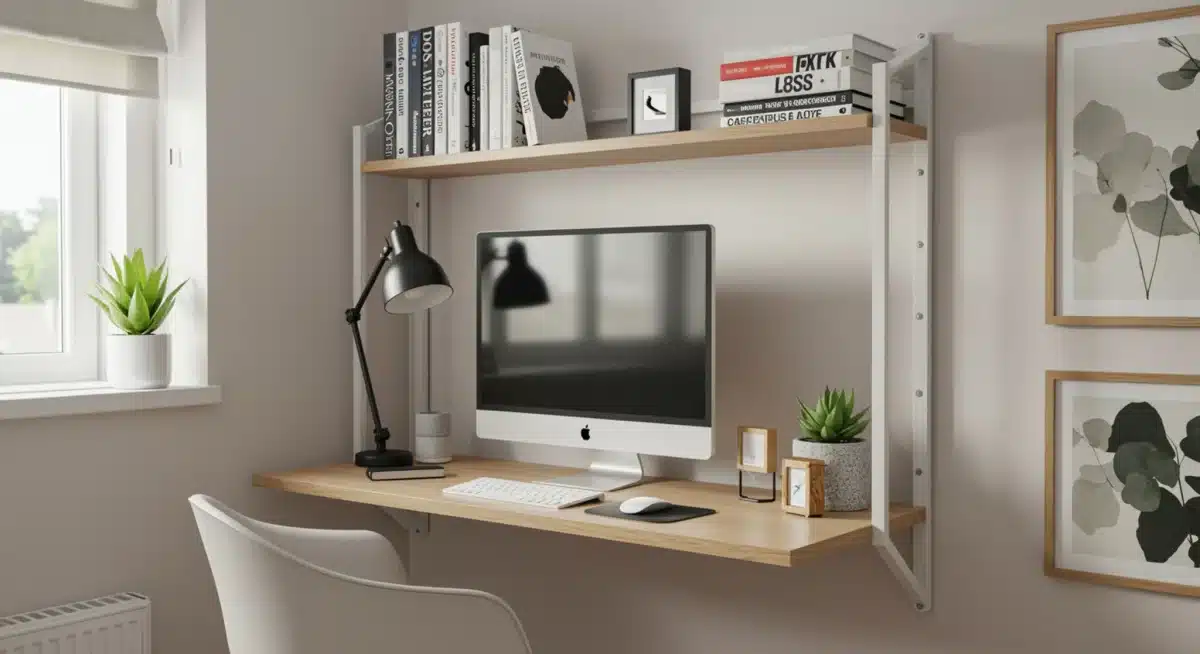

Key Furniture Pieces for Compact Offices
Selecting the right desk and chair is crucial. A floating desk or a desk with built-in storage can free up floor space. For seating, an ergonomic chair that can be tucked away or even a stylish stool can work well. Remember, comfort is key for productivity, so don’t compromise on ergonomics.
- Floating Desks: Mounted directly to the wall, these desks offer a clean look and free up floor space.
- Fold-Down Desks: Ideal for truly tiny areas, these desks can be folded up when not in use, disappearing into the wall.
- Storage Ottomans: Provide extra seating or a footrest while offering hidden storage for office supplies.
- Modular Shelving: Adaptable units that can be configured to fit various spaces and storage needs.
By prioritizing furniture that is both practical and aesthetically pleasing, you can create a small home office that feels expansive and efficient. Each item should contribute to the overall functionality and style, ensuring that your workspace remains inviting and conducive to focused work.
Maximizing Vertical Space: Storage and Organization
In a small home office, the only way to go is up. Maximizing vertical space is a non-negotiable strategy to create a stylish home office: maximize productivity in a small space without overwhelming the floor area. This involves using walls for shelving, cabinets, and even decorative elements that serve a purpose.
Think beyond traditional bookshelves; consider pegboards, wall-mounted file holders, and vertical drawer units. These solutions keep your desk clear, reducing visual clutter and making your workspace feel larger and more organized. A tidy environment is often a productive one, as it minimizes distractions and helps maintain focus.
Innovative Vertical Storage Solutions
Integrating storage seamlessly into your design is key. Open shelving can display aesthetically pleasing items, while closed cabinets can hide away less attractive but necessary supplies. Labeling containers and files also contributes to an efficient system, ensuring you can quickly find what you need.
- Wall-Mounted Shelves: Perfect for books, decorative items, and frequently used supplies.
- Pegboards: Customizable and versatile for hanging tools, stationery, and small containers.
- Vertical File Sorters: Keep documents organized and within reach without taking up desk space.
- Over-the-Door Organizers: Utilize the back of a door for additional storage of smaller items.
Effective vertical storage transforms a cramped area into a highly efficient workspace. By strategically utilizing every available inch of wall space, you not only keep your office organized but also create a visually appealing setup that inspires creativity and concentration.
Ergonomics and Comfort: Prioritizing Your Well-being
While aesthetics are important, prioritizing ergonomics and comfort is vital for long-term productivity and health, especially when you create a stylish home office: maximize productivity in a small space. A poorly designed workstation can lead to discomfort, fatigue, and even chronic pain, undermining your efficiency.
Investing in an ergonomic chair, proper monitor height, and adequate lighting are not luxuries but necessities. Even in a small space, there are many ways to optimize your setup for comfort without sacrificing style. Small adjustments can make a significant difference in how you feel at the end of a workday.
Essential Ergonomic Considerations
Your chair should support your spine, and your feet should be flat on the floor or a footrest. Your monitor should be at eye level, about an arm’s length away, to prevent neck and eye strain. Proper lighting, both natural and artificial, is also crucial to reduce glare and improve visibility.
- Ergonomic Chair: Adjustable height, lumbar support, and armrests are key features.
- Monitor Riser: Elevates your screen to eye level, preventing neck strain.
- Keyboard and Mouse Placement: Keep them close to your body to avoid reaching and wrist discomfort.
- Task Lighting: A desk lamp provides focused illumination, reducing eye fatigue.
By focusing on ergonomic principles, you ensure that your small home office is not only stylish but also a healthy and comfortable environment. This commitment to your well-being will directly translate into sustained productivity and a more enjoyable work experience, making your compact space truly effective.
Aesthetic Appeal: Design and Personalization
A stylish home office is more than just functional; it’s a reflection of your personality and a source of inspiration. When you create a stylish home office: maximize productivity in a small space, pay close attention to design elements that enhance the visual appeal and make the area feel inviting and conducive to work.
Color schemes, decor, and personal touches play a significant role in creating an atmosphere that motivates you. Even in a small space, thoughtful design choices can make the area feel larger, brighter, and more aligned with your overall home aesthetic. Avoid clutter, but embrace elements that bring you joy and focus.
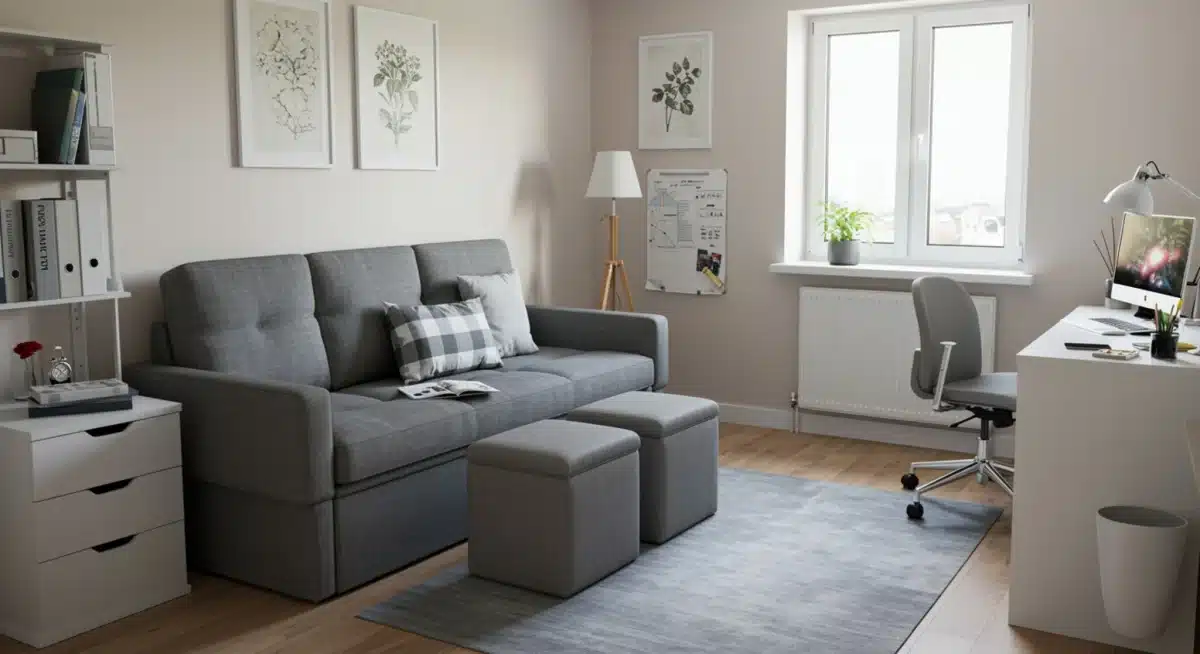

Infusing Style into Your Compact Workspace
Choose a color palette that promotes focus and tranquility. Neutrals, blues, and greens are often recommended for workspaces. Add personal touches like plants, artwork, or photos that inspire creativity without contributing to clutter. Small details can make a big impact on the overall feel of your office.
- Color Scheme: Opt for calming or stimulating colors based on your personal preference and work style.
- Greenery: Small plants not only add life but also improve air quality and reduce stress.
- Personal Accessories: Incorporate art, photos, or objects that inspire you, keeping them minimal.
- Lighting Fixtures: Choose stylish lamps that complement your decor while providing essential task lighting.
By carefully curating the aesthetic elements of your small home office, you transform it from a mere workspace into a personalized sanctuary. This attention to design ensures that your environment is not only functional but also a place where you genuinely enjoy spending time, fostering greater productivity and well-being.
Technology Integration: Streamlining Your Workflow
Modern work relies heavily on technology, and integrating it seamlessly is crucial when you aim to create a stylish home office: maximize productivity in a small space. Clutter from cables, chargers, and multiple devices can quickly overwhelm a compact area, so thoughtful planning is essential.
Prioritize wireless solutions whenever possible to minimize cable mess. Consider a docking station to manage multiple peripherals with a single connection to your laptop. Effective technology integration means your tools support your workflow without adding visual or physical clutter, maintaining the sleekness of your small office.
Managing Tech in a Limited Footprint
Concealing cables is a game-changer for cleanliness and aesthetics. Use cable management boxes, ties, and clips to keep wires tidy and out of sight. Opt for compact devices and multi-functional gadgets to reduce the number of items on your desk. A clean tech setup reinforces a professional and organized environment.
- Wireless Peripherals: Mouse, keyboard, and headphones reduce cable clutter significantly.
- Cable Management: Use sleeves, clips, and boxes to hide and organize unsightly wires.
- Docking Stations: Connect all your devices to your laptop with one simple plug, streamlining setup.
- Compact All-in-One Devices: Choose printers or scanners that are small and combine multiple functions.
Thoughtful technology integration ensures your small home office remains a highly efficient and visually appealing workspace. By managing cables and selecting compact, smart devices, you create an environment where technology enhances, rather than detracts from, your productivity and the overall aesthetic.
Maintaining Productivity: Habits and Routines
Beyond the physical setup, maintaining high productivity in a small home office also depends on establishing effective habits and routines. When you create a stylish home office: maximize productivity in a small space, the environment is just one part of the equation; your approach to work is equally critical.
Developing a consistent schedule, taking regular breaks, and setting clear boundaries can significantly enhance your focus and output. Even in a compact area, it’s possible to cultivate a routine that promotes sustained effort and prevents burnout, ensuring your small office serves its purpose effectively.
Establishing Productive Work Habits
Start your day with a clear plan and prioritize tasks. Use tools like planners or digital apps to keep track of your workload. Regular breaks are essential to prevent fatigue; step away from your desk, stretch, or grab a snack. Setting a defined end time for your workday helps maintain work-life balance, especially when your office is within your living space.
- Daily Planning: Outline your tasks and goals for the day to maintain focus.
- Scheduled Breaks: Incorporate short, regular breaks to recharge and prevent burnout.
- Digital Detox: Minimize distractions by turning off non-essential notifications.
- Clear Boundaries: Establish a routine for starting and ending your workday to separate work from personal life.
By combining a well-designed small home office with disciplined work habits, you create a powerful synergy that maximizes your productivity. This holistic approach ensures that your compact workspace is not only beautiful but also a highly effective engine for your professional endeavors, fostering both success and well-being.
| Key Point | Brief Description |
|---|---|
| Strategic Placement | Identify and utilize underutilized corners or closets for your workspace. |
| Multi-functional Furniture | Choose items that serve dual purposes to save space and reduce clutter. |
| Vertical Storage | Utilize wall space with shelves, pegboards, and wall-mounted organizers. |
| Ergonomics & Comfort | Invest in ergonomic chairs and proper monitor setup for health and productivity. |
Frequently Asked Questions About Small Home Offices
The best way is to designate a specific zone, even if it’s just a corner or a section of a room. Use visual cues like a rug, a small partition, or strategic furniture placement to create a clear boundary between your workspace and living area, signaling a shift in purpose.
To make a small office feel larger, incorporate light colors, use mirrors to reflect light and create depth, and opt for minimalist, multi-functional furniture. Maximizing vertical storage also keeps surfaces clear, contributing to an open, airy feel.
Essential ergonomic considerations include an adjustable chair that supports your back, a monitor at eye level, and a keyboard and mouse positioned to prevent wrist strain. Proper lighting is also crucial to reduce eye fatigue and maintain comfort during long work sessions.
Manage tech clutter by prioritizing wireless devices, using cable management boxes or sleeves to hide wires, and investing in a docking station. Choose compact, multi-functional gadgets to minimize the number of items occupying your limited desk space.
Absolutely. By focusing on smart design choices like multi-functional furniture, effective vertical storage, and a cohesive aesthetic, a small home office can be both highly stylish and exceptionally productive. Personal touches and good organization are key to achieving this balance.
Conclusion
Successfully creating a stylish home office that maximizes productivity in a small space is entirely achievable with careful planning and strategic choices. By focusing on location, multi-functional furniture, vertical storage, ergonomics, and aesthetic appeal, you can transform any compact area into an inspiring and efficient workspace. Remember that a well-designed environment, combined with disciplined work habits, fosters not just productivity but also overall well-being. Embrace the challenge of small spaces as an opportunity for innovative design and a more focused approach to your professional life, proving that size is no barrier to a truly effective and beautiful home office.
